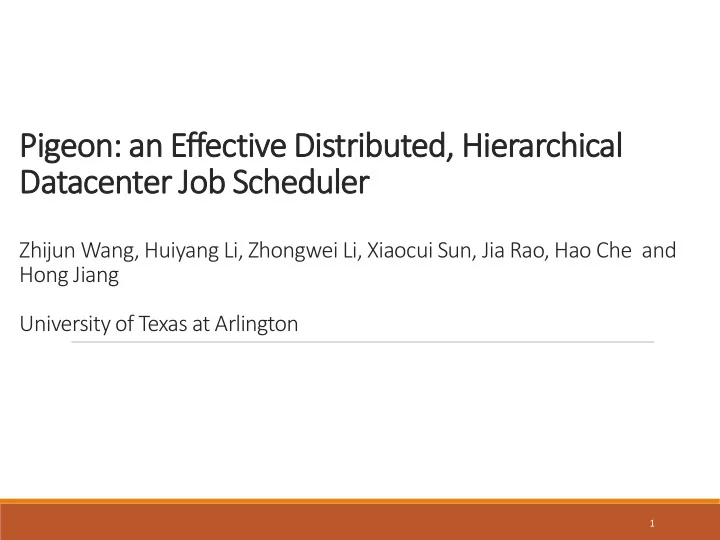

Pigeo eon: a an Effec ective D e Distrib ibuted ed, Hier erarchic ical Datacen enter Job ob S Sched eduler ler Zhijun Wang, Huiyang Li, Zhongwei Li, Xiaocui Sun, Jia Rao, Hao Che and Hong Jiang University of Texas at Arlington 1
Datacenter job scheduling challenges-I Large scale Cluster size is large Tens of thousands of nodes/workers The number of tasks in a job can be larger Tens of thousands of tasks in a job -- More than 50K tasks in a job in the Cloudera trace 2
Datacenter job scheduling challenges-II Heterogeneous workload Short jobs (e.g., user facing applications ) ---call for short response time Long jobs (e.g., Data backup) --call for mean response time guarantee 3
Centralized job scheduling Scalability problem A scheduler manages all the workers’ resources in a cluster Workers Scheduler short job Job task queue long job task queue 4
Distributed scheduling-Sparrow Low efficinecy: unbalanced probing Scheduler Job Workers task queue A scheduler needs to maintain all probes. 5
Hybrid scheduling-Eagle, Hawk All short jobs are put to reserved workers Scalability problem Centralized Long job Workers task Scheduler queue Distributed Scheduler Short job Reserved workers: only serve short job tasks 6
Pigeon Contributions 1. Introduce a master level for task distribution New architecture, hierarchical job scheduler 2. Fully solve scalability problem 3. High efficiency 7
Centrally manage a Dispatch tasks to group of workers workers Overview of Pigeon Master is job agnostic Master Distributed group of workers Scheduler Jo b Reserved Task workers 8
Job scheduling in Pigeon workers Weighted fair queue (W) Idle worker list Job Distributed Scheduler 9
Why is Pigeon better? Solve key challenges in existing schedulers Scalable: greatly reduce status maintenance costs in job schedulers Group size 100: # of master is 1% # of workers, reduce 99% status maintenance cost Efficiency: Remove head-of-line blocking Have statistical multiplexing gain w ithin a group Group size 100: run at 90% load, the probability of a task finding an idle worker in a group is 1-0.9 100 =99.99734!! 10
Modeling and Analysis Consider a single type of jobs, the fanout degree in a job is less than the number of masters. The task queuing time in a master is a M/M/K queue (K is the group size) Running at 30% higher utilization Zero queueing time: job w ithout queuing time, The task execution time in a job is the same 11
Evaluation--Implementation Spark plug-in, Amazon EC2 cloud 120-w orker cluster (3 groups in Pigeon) Measurement metrics: 50th, 90th and 99th percentile short and long job completion time Compare w ith state-of-the-art schedulers: Eagle and Sparrow Source codes: https://github.com/ruby-/pigeon/ 12
Pigeon vs Eagle--Implementation Eagle normalized to Pigeon 20x~ 30x short job performance gains 13
Pigeon vs Sparrow--Implementation Sparrow normalized to Pigeon Pigeon w orks in a real cluster 14
Evaluation—Large Scale Simulation Event-driven simulator Google, Yahoo and Cloudera traces Cluster size 3000--19000 w orkers Measurement metrics: 50th, 90th and 99th percentile short and long job completion time Compare w ith state-of-the-art hybrid scheduler: Eagle 15
Pigeon is really scalable and efficient Google trace Eagle Slow dow n=job completion time / job execution time Big performance gains for short job at high loads Slightly better performance gains for long jobs 16
Conclusion Pigeon: a new distributed and hierarchical job scheduler, new scheduling architecture 1. Excellent scalability better than existing schedulers 2. High efficiency with multiplexing 17
Thank you! Questions ?? 18
Recommend
More recommend